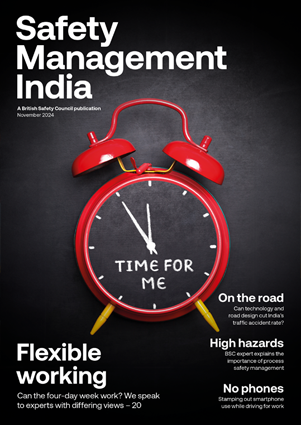The post-pandemic shift to home and hybrid working poses challenges for ensuring the health, safety and wellbeing of workers, but the starting point should always be the careful assessment, discussion and management of risks like home workstations, electrical dangers and mental wellbeing.
Features
Home but not alone
Back at the height of the Covid-19 pandemic I wrote an article. It was titled ‘Home Alone’ and I reflected on the impact of home working during a pandemic and its immediate aftermath.
If you’ve read it, I think it is fair to say that some of the questions raised and some of my predictions seem to have now become the norm for many organisations.
Despite all Covid restrictions affecting UK businesses being lifted almost 18 months ago, many companies that I work with as a health and safety auditor and advisor still have a hybrid working model and haven’t yet decided if this will be a permanent change to their working model. Some, for a variety of reasons, have chosen to make it mandatory for staff to return to the office and can, because of the nature of their work, justify the approach due to a genuine business need.
![]()
![]() Arguably, the biggest cultural shift for most workers who have moved to home or hybrid working has been adjusting from working alongside colleagues in the office to working with the same people virtually. Photograph: iStock
Arguably, the biggest cultural shift for most workers who have moved to home or hybrid working has been adjusting from working alongside colleagues in the office to working with the same people virtually. Photograph: iStock
I know many safety practitioners are required to address the health, safety and wellbeing concerns of home workers within their business. Employers’ responsibilities for ensuring the health and safety of home workers are well known and most safety practitioners understand they need to comply with the duty to ensure the safety of the home worker’s working environment, display screen equipment (DSE) workstation and any DSE equipment and furniture used or provided.
However, there is perhaps a lower level of understanding among employers, line and HR managers and safety practitioners about how to effectively support the mental and physical health of home workers, help them to motivate and organise themselves and encourage them to maintain a good work-life balance.
Key HSE guidance
To its credit the Health and Safety Executive (HSE) has provided guidance on the key risks employers should consider, such as managing work-related stress and supporting mental health, ensuring safe computer use and maintaining a safe home working environment.
The requirement to provide safe DSE equipment to home workers is a given but the question then arises about how an employer can ensure the equipment is used, checked and maintained in a way that it doesn’t pose a risk either of personal injury or in the worst case a fire? The employer’s duty of care to ensure the safety of home workers’ DSE and electrical equipment, it can be argued, now extends to those who live at the property.
 Phil Pinnington:"Home workers have an important role to play by following the guidance provided."
Phil Pinnington:"Home workers have an important role to play by following the guidance provided."
This is something safety practitioners have never really had to consider before to any great extent. Unfortunately, there is a lack of detailed guidance on how to ensure that electrical equipment used by home workers (such as DSE and the worker’s own sockets and extension leads) is maintained in a safe condition, so practitioners need to establish policies, standards and procedures that address this possibly complex issue.
The regulations governing workplace safety do give general guidance (such as making clear the risks to all workers must be assessed regardless of their location and electrical equipment provided by the employer must be maintained to prevent danger) but we have to accept they were written in the 1990s when home working was simply not as widespread as it is today.
However, employers have long had a duty to carry out risk assessments and take ‘reasonably practicable’ measures to protect workers’ health and safety and this should be the starting point for practitioners when looking to manage the risks from home working.
Clearly, an employer’s duty to ensure the health and safety of workers is not lessened in any way when people work from home but there has to be an acceptance and understanding among home workers themselves that they have an equally important role to play by co-operating with their employer on safety matters, following the guidance provided and taking all possible steps to look after their own health and safety.
Arguably, home workers have a slightly greater responsibility for ensuring their home environment and working practices are safe and healthy than the employer simply because they can more quickly spot problems like an unsafe electrical cable or back ache from an uncomfortable workstation. However, at the outset employers must still provide the appropriate training and reasonable supervision to ensure employees are abiding by the agreed rules.
Sensible compromise
Some employers have decided to visit workers’ homes to assess the working conditions, workstation, electrical risks and how computer equipment (whether employer-provided or employee-owned) is being used. Although this is often essential if staff carry out information-sensitive activities where a computer security breach could have major implications, for the majority of employers it would be impractical and extremely costly to visit homes to conduct risk assessments of workstations, working environments and electrical equipment.
Therefore, generally speaking there must be a sensible compromise on how the risks will be assessed and managed. Although an employer is strictly only responsible for ensuring the safety of electrical equipment they provide (such as DSE and printers), they should ensure it is being used in a safe environment and should ask employees to visually check for problems like damage to sockets, plugs or leads used in connection with their work, even if these are owned by the worker.
 The world has re-opened but this doesn’t mean the risk to the mental health of home and hybrid workers has disappeared. Photograph: iStock
The world has re-opened but this doesn’t mean the risk to the mental health of home and hybrid workers has disappeared. Photograph: iStock
Crucially, the employee must also ensure they always follow the training given on how to spot, report and deal with hazards, such as electrical safety and fire risks. Where necessary, this also includes problems such as uncomfortable workstations, aches and pains, and stress and mental health problems arising from their work.
Reasonable steps
Employers must take all reasonable steps to ensure home-based workers have a suitable home working set-up and can achieve a comfortable, sustainable posture while working with DSE. Some employers have provided office-type furniture but some employees have neither the space nor the desire for a large desk and chair so it’s important the employer and employee reach a consensus about what is an acceptable safe workstation based on the results of the DSE risk assessment and conversations between the manager and worker.
However, it is a good idea for the employer to set minimum standards for workstations and working environments and more importantly to specify the type of risky home setups that must be avoided due to the danger of musculoskeletal problems and associated health issues like fatigue and stress.
Generally, employers should always seek to ensure employees are not working from unsuitable workstations such as kitchen tables or cramped surfaces and spaces in bedrooms. If this is the case it may be necessary, depending on the circumstances of the employee and the business, to discuss whether the worker should return to the office or work at another suitable agreed location.
In short, although the employer is not responsible for the general safety of an employee’s home they are still legally responsible for ensuring the worker has a safe place to work while at home.
Supporting mental wellbeing
Arguably, the biggest cultural shift for most workers who have moved to home or hybrid working has been adjusting from working alongside colleagues in the office to working with the same people virtually.
During the pandemic, managers and workers were regularly reminded to check-in with colleagues to offer support and advice around mental and physical health risks, such as high workloads, long working hours, feelings of isolation and maintaining a good work–life balance.
Clearly, lockdowns, movement restrictions and online working had a negative impact on everyone’s mental wellbeing and although many suffered, employers and colleagues sought to provide the best support possible in the circumstances.
The world has re-opened and people are taking the opportunity to do the things they yearned to do during the time of restrictions, but this doesn’t mean the risk to the mental health of home and hybrid workers has disappeared.
For instance, home workers may still experience feelings of isolation or disconnection due to the lack of social contact, which can bring on pressure and stress; may struggle to manage their time, organise themselves and maintain a good work–life balance; be tempted to work longer hours; and may struggle to get adequate support if they are struggling with workloads and feelings of stress.
Also, those who tend to feel more energised through face-to-face, human interaction may face a particular struggle to maintain their motivation and a positive frame of mind for effective and productive working.
It is therefore crucial that safety practitioners and HR and wellbeing professionals constantly monitor the mental health of home and hybrid workers. Ways of achieving this include through regular one-to-one and team discussions (both virtually and if possible face-to-face); and talking openly to staff about issues such as workloads, working hours, changes at work, any occupational support available and the possibility of them becoming stressed or mentally unwell.
It is estimated that, technologically, the pandemic has catapulted business norms about five years further ahead than where we would have been if we hadn’t had a pandemic. We can be proud of our resilience and innovation but we should never forget the human impact of change.
Phil Pinnington is Acting head of audit and consultancy at the British Safety Council


FEATURES
Why changes to recycling legislation in England are an opportunity, not a burden
By on 12 November 2024

Road safety in India: could better road safety, vehicle technology and enforcement make driving for work safer?
By Orchie Bandyopadhyay on 10 November 2024
India has a poor road safety record, and research shows that commercial vehicles are a major contributor to the problem, with trucks estimated to be the single largest vehicle type involved in impacts leading to fatalities. We look at solutions that could make driving for work and the roads in general safer – from in-vehicle technology that warns truck drivers about unsafe behaviour to improving the design features of major highways.

